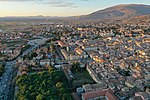Vescia
Vescia was an ancient city of the Ausones (a subgroup of the Aurunci), in what is now central-southern Italy, which was part of the so-called Auruncan Pentapolis and was destroyed by the Romans in 340 BC. It was a fortified center, located perhaps on the left shore of the Garigliano river, in the current comuni of Cellole and Sessa Aurunca, where remains of pre-Romans walls have been found. According to some sources, it was located on the Monte Massico, where there also ancient remains including a subterranean aqueduct and large mosaic pavements. Two Latin inscriptions referring to Vescia, dating to 211-212 AD, have been found in Castelforte, Formia, in the southern province of Latina. These are now in the Archaeological Museum of Minturno.
Excerpt from the Wikipedia article Vescia (License: CC BY-SA 3.0, Authors).Vescia
Via Donato Bramante,
Geographical coordinates (GPS) Address Nearby Places Show on map
Geographical coordinates (GPS)
| Latitude | Longitude |
|---|---|
| N 42.983333333333 ° | E 12.733333333333 ° |
Address
Via Donato Bramante
Via Donato Bramante
06034
Umbria, Italy
Open on Google Maps








